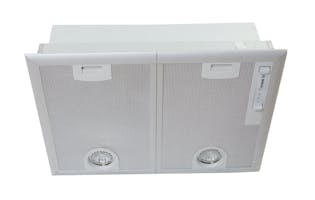How ducting types and installation can make your rangehood quieter

Aside from extraction performance, noise is one of the top considerations when buying a rangehood. Rangehoods can be very noisy, especially on higher fan speeds.
Some of our tested models were recorded at over 70 decibels on the highest setting (around the noise level of a standard vacuum cleaner), which for prolonged periods of time can be extremely annoying.
There are several factors that can influence how loud a rangehood is; canopy design, motor efficiency and room environment amongst them, but one that is often misunderstood is the ducting type.
Types of ducting

Flexible
Flexible ducting is the cheapest of all ducting types, the easiest to install and commonly used in ventilation systems like HRV and DVS. Lightweight and easy to bend around corners, it consists of a steel coil covered in a membrane, which is often PVC with a foiled coating.

Semi-rigid
Semi-rigid ducting is also flexible but not quite as bendy as flexible ducting, is made from an aluminium spiral and has a smoother internal bore.

Rigid
Rigid ducting is made from galvanised or stainless-steel sheeting and is ideal for long straight runs. It has a smooth internal bore. Rigid ducting is great for rural homes where rodents could be a problem as they can eat through flexible ducting.
Price
Rigid and semi-rigid ducting can typically be two to three times the price of flexible ducting.
The quietest option
This is a contentious subject! It mainly comes down to the skill of the installer.
If installed correctly, flexible ducting can be one of the quietest options for rangehood ducting (and the cheapest), but many retailers won’t recommend using it due to poor installs and subsequent warranty claims.
If flexible ducting isn’t extended fully it will bunch up and impede air flow, thus creating turbulence and increasing noise levels. Squeezing flexible ducting through small gaps can also increase the noise due to the fan having to work harder to push the air through the narrower section.
Therefore, many retailers and manufacturers recommend semi-rigid or rigid ducting, but these come with more expensive installation and increased material costs.
In an ideal world, the duct would have a straight run from the rangehood to the outside. But, for most installs, the secret to keeping the noise down is to minimise the length of the duct and reduce the number of bends.
Replacing a rangehood
If you are replacing an older rangehood, it pays to check the diameter of the original ducting, as it could be 125mm in diameter, while new models tend to have 150mm outlets. Often newer models are connected to the old, narrower ducting using an adaptor. This reduces air flow and efficiency and increases noise.
Our testing installation
When we test rangehoods in our lab, we use a rigid PVC pipe to remove any of the variation that flexible ducting might introduce. This means we have a near-perfect set-up, so noise levels recorded can often be lower than those you may experience with a home installation. You should use our noise level readings for comparing tested models only. Manufacturers’ noise readings cannot be compared with our readings as there is no way of knowing how the manufacturers installed their units or where they were standing relative to the rangehood to test the sound level.
We've tested 82 rangehoods.
Find the right one for you.
Award
.jpg&w=315&q=75)
Award
.jpg&w=315&q=75)
Bosch

Member comments
Get access to comment